
Tablet Weaving and Ply-Splitting Books, Tools & Kits
Recommended Links and Resources
I have included some of my own work plus books, tools, people, organizations, practices and web sites that I like and recommend. This page will always be a work in progress. If you have updates about tablet weaving and ply-splitting (books, articles, websites, etc. that are not listed here), please let me know.
Tablet Weaving
Ply-Splitting
Textile-Related Links
Garden Art from Recycled Materials
Mindfulness Practice
Healthy Cooking and Eating
Tablet Weaving
Web Sites featuring Tablet Weaving
TWIST
Internet Discussion List
Articles, Books, and DVDs
Tools and Techniques
Web Sites featuring Tablet Weaving
Peter Collingwood -- Examples of Peter's tablet weaving in the Visual Arts Data Service.
Inge Dam -- Master Weaver and teacher, incorporates tablet weaving into fabrics by weaving the tablet borders and bands simultaneously with the fabric on the loom. Gallery includes many photos of jackets and shawls using this technique. Tablet weaving workshops include 3/1 broken twill, pebble weave, missed hole technique, brocading and more.
Eckhard Gartz -- an application for designing patterns in a variety of techniques ("Gutram's Tabletweaving Thingy"), many photos of bands, metal tablets.
Sarah Goslee -- class handouts, theory, patterns, photos, and more.
Kurt Laitenberger -- many photos of a wide variety of structures and designs including knotwork, animals, letters; weaving with 2 or 3 holes per tablet; hexagonal tablets.
John Malarky -- TabletWeaver software and many photos of bands.
Gudrun Polack -- software for tablet weaving.
Janis Saunders -- An information page for weavers, specifically for those interested in Tablet Weaving, Kumihimo, and Ply-splitting. Photo galleries of tablet weaving by many individuals; instructions, news, information, and many links.
Marijke van Epen -- author of The Unknown Tablet Weaving (traditional designs from the South American Andes), Special Tablet Weaves (traditional designs from Sulawesi, Indonesia), and several other tablet weaving pattern books; photos of her work, including tablet-woven bands, bags, and scarves in many structures.
Claudia Wollny -- author of instruction books with patterns in the 3/1 broken twill, Die fabelhafte Welt der brettchengewebten Stola und Maniple zu St. Donat, Arlon. | The Wonderful World of the Tablet-Woven Stole and Maniple of St. Donat, Arlon. and Der Lilienhain | A Lily Grove. 4-hole and 6-hole tablets, weaving patterns and free downloads.
TWIST -- Tablet Weavers' International Studies & Techniques
TWIST promotes appreciation of tablet weaving and development of skills through a newsletter, exhibitions, and an Internet discussion group. The newsletter is written by the members, and is distributed three times per year. Topics include letters, techniques, technical tips, historical articles, product news, and announcements of interest to tablet weavers. Formed in 1994, our group now has more than 300 members worldwide. A great way to keep in touch with other tablet weavers.
For information on how to join TWIST and receive its journal, visit the TWIST "Join" page.
TabletWeaving Internet Discussion List
Learn about this list and sign up at Janis Saunders' web site, www.weavershand.com. This site is a wonderful resource for information about both tablet weaving, ply-split braiding, kumihimo, and other textile arts, and has links to many other sites.
Articles and Books about Tablet Weaving
You can order my self-published books from my Tablet Weaving Books page. In the section below, I have provided links to other authors, so you can e-mail them for information about where to purchase their books. Additional articles can be found at the Digital Archive of Documents Related to Tablet Weaving.
by Peter Collingwood:
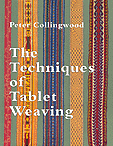 The Techniques of Tablet Weaving, the most comprehensive book on the subject. This is my favorite tablet weaving book, which I have studied for the past ten years, but have not yet managed to read all the way through. I have most carefully read the large chapter on the double-faced weaves, and this book has been a great inspiration to me in my own writing on that subject.
The Techniques of Tablet Weaving, the most comprehensive book on the subject. This is my favorite tablet weaving book, which I have studied for the past ten years, but have not yet managed to read all the way through. I have most carefully read the large chapter on the double-faced weaves, and this book has been a great inspiration to me in my own writing on that subject.
320 pages, paperback edition with same text as the original but new format; 232 B&W photos, 242 illustrations. Historical introduction, equipment, a variety of warping methods, warp twining, plain weave, hopsack, gauze, twill, double-face, double cloth, triple cloth, brocade, tapestry, velvet, and special warp and weft manipulations.
by Candace Crockett:
Card Weaving, revised edition published by Interweave Press, 141 pages, 1991. This is the book I recommend for beginners. I particularly recommend Chapter 6, Dark and Light Patterning, which introduced me to continuous warping, and arranging and turning the tablets for constantly changing warp-twined and double-faced designs.
by Herbi Gray
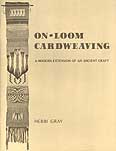 On-Loom Cardweaving: A Modern Extension of an Ancient Craft, 60 pages, self-published, 1982. An inspiring book from a pioneer of contemporary tablet weaving. This book showed me how to use a reed with the tablets to create soft, drapeable, and even lacy fabrics in plain weave, basket weave, and leno (gauze weave), and inspired my tablet-woven scarves. You can use a loom to tension the warp, as described in the book, or you can use tensioning blocks with a length of reed hanging on the warp. The reed is used to beat every pick so you can create soft, even airy fabrics. About half of the book is devoted to instructions for turning the tablets to produce a sampler which includes balanced plain weave, leno variations, log cabin, double weave, honeycomb, warp floats, twisted or displaced warp groups, and simultaneous use of more than one technique. Lots of black & white photos and illustrations, and many wonderful ideas for a creative person to explore.
On-Loom Cardweaving: A Modern Extension of an Ancient Craft, 60 pages, self-published, 1982. An inspiring book from a pioneer of contemporary tablet weaving. This book showed me how to use a reed with the tablets to create soft, drapeable, and even lacy fabrics in plain weave, basket weave, and leno (gauze weave), and inspired my tablet-woven scarves. You can use a loom to tension the warp, as described in the book, or you can use tensioning blocks with a length of reed hanging on the warp. The reed is used to beat every pick so you can create soft, even airy fabrics. About half of the book is devoted to instructions for turning the tablets to produce a sampler which includes balanced plain weave, leno variations, log cabin, double weave, honeycomb, warp floats, twisted or displaced warp groups, and simultaneous use of more than one technique. Lots of black & white photos and illustrations, and many wonderful ideas for a creative person to explore.
by Linda Hendrickson:
"Tablet-Woven Leashes for Spike and Jones", an online article for Handwoven magazine, Summer 2006.
Please Weave a Message: Instructions and Graphs for Tablet-Woven Calligraphy, 144 pages, self-published, 2003.
"Tablet-Woven Gauze Scarves", Weaver's, Spring 1999, p. 64-65.
"Tablet Weaving", Journal for Weavers, Spinners and Dyers (England), September 1998, p. 36-38.
"S p a c e d O u t Tablet Warps!", Weaver's, Issue 40, Summer 1998, p. 46-49.
"Double-Faced Tablet Weaving", Weaver's, Spring 1997, p. 38-41.
Review of The Techniques of Tablet Weaving by Peter Collingwood, Weaver's, Fall 1996, p. 52.
Review of Tablet Weaving in True Nordic Fashion by Sonja Berlin, Handwoven, March/April 1996, p. 13-14.
"Tablet Weaving", Shuttle Spindle and Dyepot, Spring 1996, p. 48-49.
Double-Faced Tablet Weaving: 50 Designs from Around the World, 120 pages, self-published, 1996.
Weave A Neckpiece (Using Tubular Cardweaving Techniques), 43-minute instructional video produced by Victorian Video Productions in 1996, now available in streaming format from Taproot Video. This is a good introduction to the basics of tablet weaving, even if you don't want to weave a neckpiece. I show how to make a continuous warp (view this segment on my Free Instructional Videos page), how to flip and rotate individual tablets to create a variety of geometric patterns in warp twining, and how to weave a flat band and a seamless tube. The production quality is excellent.
"Weaving with a Twist: Get Ready to Flip, Rotate, Turn", Weaver's, Spring 1996, p. 46-49.
Tablet Weaving for Parents and Children, 16 pages, self-published, 1995.
Tubular Cardwoven Neckpieces: Modern Adornment from an Ancient Weaving Technique, 40 pages, 8-1/2"x 11", published by Robin & Russ Handweavers in 1994. My first book, with instructions for making the "10-minute warp", how to flip and turn the tablets for simple geometric patterns in warp twining, how to weave a tube, hints on designing necklaces, and a variety of necklaces shown in color.
"It's All in the Cards -- Tubular Cardwoven Necklaces", Handwoven, Sept./Oct. 1993, p. 72-76.
by Nancy Spies:
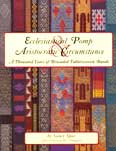 Ecclesiastical Pomp & Aristocratic Circumstance: A Thousand Years of Brocaded Tabletwoven Bands, 315 pages, paperback, self-published in 2000. For anyone interested in the history of textiles, especially those who wish to reproduce brocaded tablet-woven bands with historical accuracy. Approximately 70 historical patterns never before published, glossary, extensive annotated bibliography, and detailed documentation on every known brocaded tablet-woven band made in Europe between 600 and 1600. At the time, these textiles of silk and precious metallic threads were "one of the most luxurious forms of personal ornament". Charming line drawings of medieval churchmen and royalty show exactly where the bands were placed, from their headpieces right down to their shoes. Exhaustive analysis of colors and dyes, threads, weaving methods, and tools used by medieval tablet weavers.
Ecclesiastical Pomp & Aristocratic Circumstance: A Thousand Years of Brocaded Tabletwoven Bands, 315 pages, paperback, self-published in 2000. For anyone interested in the history of textiles, especially those who wish to reproduce brocaded tablet-woven bands with historical accuracy. Approximately 70 historical patterns never before published, glossary, extensive annotated bibliography, and detailed documentation on every known brocaded tablet-woven band made in Europe between 600 and 1600. At the time, these textiles of silk and precious metallic threads were "one of the most luxurious forms of personal ornament". Charming line drawings of medieval churchmen and royalty show exactly where the bands were placed, from their headpieces right down to their shoes. Exhaustive analysis of colors and dyes, threads, weaving methods, and tools used by medieval tablet weavers.
by Otfried Staudigel:
 Tablet Weaving Magic: Patterns from Oriental Countries and 25 Patterns in Plain Tablet Weave, 250 pages, paperback, self-published in 2000 with text in both English and German. Otfried Staudigel has been teaching tablet weaving for over 50 years. In this book, he clearly explains his methods, and presents instructions and graphs for weaving beautiful traditional designs from Asia. The section on double-faced designs includes Persian bands with peacocks, flowers, and the tree of life; as well as Burmese bands with incense burners, parasols, bells, people, birds, and animals. The section on warp-twined bands includes a valuable and detailed description of using the continuous warping method for patterns determined by the threading; this involves cutting and tying on new colors as needed. The 25 patterns include the Running Dog, Ram's Horn, and Star of David.
Tablet Weaving Magic: Patterns from Oriental Countries and 25 Patterns in Plain Tablet Weave, 250 pages, paperback, self-published in 2000 with text in both English and German. Otfried Staudigel has been teaching tablet weaving for over 50 years. In this book, he clearly explains his methods, and presents instructions and graphs for weaving beautiful traditional designs from Asia. The section on double-faced designs includes Persian bands with peacocks, flowers, and the tree of life; as well as Burmese bands with incense burners, parasols, bells, people, birds, and animals. The section on warp-twined bands includes a valuable and detailed description of using the continuous warping method for patterns determined by the threading; this involves cutting and tying on new colors as needed. The 25 patterns include the Running Dog, Ram's Horn, and Star of David.
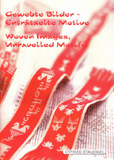 Woven Images, Unravelled Motifs: Double-Faced Tablet-Woven Bands from Burma, Tibet and Tunisia. 192 pages, paperback, self-published in 2008 with text in both English and German. In this book, Otfried Staudigel continues his valuable work that he first shared in Tablet-Woven Magic, this time exclusively focusing on double-faced bands. The majority of graphs in this book are from Burmese manuscript binding ribbons known as sazigyo. These designs include several examples of the Zey Yattu, the opening prayer for good auspices, and many other images important in Buddhist iconography that appear on sazigyo, including a variety of animals, frogs, fish, trees and flowers, gongs, bells, nats (spiritual beings), and ritual objects. Otfried has researched meanings of the images, and shares this information in the text that accompanies the graphs.
Woven Images, Unravelled Motifs: Double-Faced Tablet-Woven Bands from Burma, Tibet and Tunisia. 192 pages, paperback, self-published in 2008 with text in both English and German. In this book, Otfried Staudigel continues his valuable work that he first shared in Tablet-Woven Magic, this time exclusively focusing on double-faced bands. The majority of graphs in this book are from Burmese manuscript binding ribbons known as sazigyo. These designs include several examples of the Zey Yattu, the opening prayer for good auspices, and many other images important in Buddhist iconography that appear on sazigyo, including a variety of animals, frogs, fish, trees and flowers, gongs, bells, nats (spiritual beings), and ritual objects. Otfried has researched meanings of the images, and shares this information in the text that accompanies the graphs.
Click here to see images from my sazigyo with typical motifs and comments by Ralph Isaacs.
by Marijke van Epen
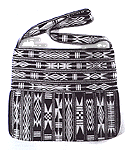 "Cardwoven Andean Pebble Weave", Weaver's, Issue 32, Summer 1996, p. 42-44.
"Cardwoven Andean Pebble Weave", Weaver's, Issue 32, Summer 1996, p. 42-44.
Special Tablet Weaves, 37 pages, spiral bound, self-published, English translation by Liesel van Cleef and Ruth Beck, 1994. Instructions and graphs for weaving the two- and three-color weaves of Indonesia. English edition self-published 2000. Instructions and graphs for weaving traditional two and three-color double-faced designs from Sulawesi, Indonesia. Please note: Graphs are drawn for the one-pack method. Information about weaving the bands found in a man's betel bag shown here, now in the Royal Tropical Institute, Amsterdam.
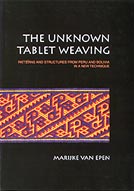
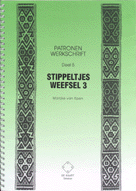
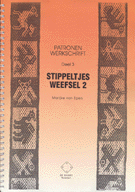 Stippeltjes Weefsel 2, 27 pages, spiral bound, text in both English and Dutch, self-published in 2001. Instructions and graphs for weaving traditional designs from the Andes with tablets (a non-traditional method developed by Marijke). Graphs for patterns from 4 - 48 tablets, mostly for 2-hole pebble weave. This is an easy technique, suitable for beginners.
Stippeltjes Weefsel 2, 27 pages, spiral bound, text in both English and Dutch, self-published in 2001. Instructions and graphs for weaving traditional designs from the Andes with tablets (a non-traditional method developed by Marijke). Graphs for patterns from 4 - 48 tablets, mostly for 2-hole pebble weave. This is an easy technique, suitable for beginners.
Stippeltjes Weefsel 3, 26 pages, spiral bound, text in both English and Dutch, self-published in 2002. Instructions and graphs for weaving traditional designs from the Andes with tablets (a non-traditional method developed by Marijke). Graphs for patterns from 8 - 44 tablets, for 2-, 3-, and 4-hole pebble weave. Additional holes are threaded with different colors, and the designs become more intricate.
The Unknown Tablet Weaving, 191 pages, self-published, 2002. Textiles of the Andes are famous for their rich patterns and their complex techniques. Marijke studied the traditional structures and determined how to weave them with tablets. This beautiful book, originally published in Dutch, is now available in English. Step-by-step descriptions of basic techniques, many illustrations, more then 200 pattern diagrams. Emphasis on learning to read patterns as well as design your own. Indigenous ways of embellishing and finishing woven pieces as well as the original weaving methods are described in separate chapters.
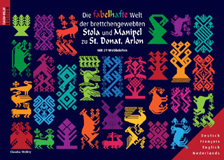 by Claudia Wollny
Die fabelhafte Welt der brettchengewebten Stola und Maniple zu St. Donat, Arlon. Mit 29 Webbriefen. | The Wonderful World of the Tablet-Woven Stole and Maniple of St. Donat, Arlon With 29 Weaving patterns. 128 pages, 123 photos, 5 illustrations, in full color. Published by Claudia Wollny Edition, May 2015. Motifs include deer, dogs and two-headed snakes. Woven in the High Middle Ages (around 1,000 years ago), the stole and maniple are now in the museum en Piconrue, Bastogne (Belgium). The museum is currently striving to have them recognized as items of cultural heritage, as they are of inestimable value. The book contains photos of the originals and reproductions as well as patterns for all 29 motifs. Detailed notes provide information about the colors and weaving technique. Anyone with at least basic knowledge of tablet weaving can reproduce the motifs. The weaving patterns are for 87 pattern tablets in the 3/1 twill technique. The text is given in four languages: German, English, French, Dutch.
by Claudia Wollny
Die fabelhafte Welt der brettchengewebten Stola und Maniple zu St. Donat, Arlon. Mit 29 Webbriefen. | The Wonderful World of the Tablet-Woven Stole and Maniple of St. Donat, Arlon With 29 Weaving patterns. 128 pages, 123 photos, 5 illustrations, in full color. Published by Claudia Wollny Edition, May 2015. Motifs include deer, dogs and two-headed snakes. Woven in the High Middle Ages (around 1,000 years ago), the stole and maniple are now in the museum en Piconrue, Bastogne (Belgium). The museum is currently striving to have them recognized as items of cultural heritage, as they are of inestimable value. The book contains photos of the originals and reproductions as well as patterns for all 29 motifs. Detailed notes provide information about the colors and weaving technique. Anyone with at least basic knowledge of tablet weaving can reproduce the motifs. The weaving patterns are for 87 pattern tablets in the 3/1 twill technique. The text is given in four languages: German, English, French, Dutch.
 Der Lilienhain. 100 und 1 Brettchenwebmotive im Arlon-Stil. Mit 164 Webbriefen. | A Lily Grove. 100 and 1 Tablet Weaving Designs in the Arlon Style with 164 Weaving Patterns. 176 pages, 34 photos, 20 illustrations, in full color. A display of projects that can be woven in the style of the original designs . The topic is Lilies, a symbol of rebirth. Designs for a maximum of 35 tablets, newly designed and sorted by topic: Lilies, dogs, snakes, large four-legged creatures, birds, as well as floral and decorative ornaments. All designs can easily combined and the most can be woven with fewer tablets. The weaving patterns are supported by basic instructions for tablet weaving, making a circular warp and the 3/1 twill technique, illustrated by clear drawings. Additionally, there are more than 30 suggestions for border designs. The weaving patterns are for 35 pattern tablets in the 3/1 twill technique. The text is given in German and English. The weaving patterns are drawn in a way that they can be woven without previous knowledge of the 3/1 twill technique.
Der Lilienhain. 100 und 1 Brettchenwebmotive im Arlon-Stil. Mit 164 Webbriefen. | A Lily Grove. 100 and 1 Tablet Weaving Designs in the Arlon Style with 164 Weaving Patterns. 176 pages, 34 photos, 20 illustrations, in full color. A display of projects that can be woven in the style of the original designs . The topic is Lilies, a symbol of rebirth. Designs for a maximum of 35 tablets, newly designed and sorted by topic: Lilies, dogs, snakes, large four-legged creatures, birds, as well as floral and decorative ornaments. All designs can easily combined and the most can be woven with fewer tablets. The weaving patterns are supported by basic instructions for tablet weaving, making a circular warp and the 3/1 twill technique, illustrated by clear drawings. Additionally, there are more than 30 suggestions for border designs. The weaving patterns are for 35 pattern tablets in the 3/1 twill technique. The text is given in German and English. The weaving patterns are drawn in a way that they can be woven without previous knowledge of the 3/1 twill technique.
Tablet Weaving Tools and Techniques
Over the years, I have studied and perfected traditional tools and techniques -- and invented new ones -- to make tablet weaving more orderly and efficient. These include the A-B line, continuous warping, the warping wand, tablet holder, adjustable warp spreader, and others.
Tablet weaving tools are available for purchase by mail order. All of the wooden tools are made by my husband, John Brockway,
Ply-Splitting
Web Sites featuring Ply-Splitting
Ply-split Internet Discussion Group
Articles, Books, and Videos
Tools
The Braid Society
Web Sites showing Ply-Splitting
Ply-Split Braiding . A central resource for all things ply-splitting
The Braid Society (UK). Photos of ply-split sculptures, jewelry, and accessories.
Barry Brown (England). Ply-split baskets, braids, curtain tie-backs.
Conference of Northern California Handweavers. Scroll down to find Martha Stanley's "ply split sisal floor doily".
Therese Fisher, (California). Ply-split baskets, sculptures, a neck pouch, and a scarf.
David Fraser (Pennsylvania). Author of a book and articles on ply-split braiding, many photos of ply-split vessels and sculptural forms in waxed linen, with a focus on POT (plain oblique twining).
Louise French (Minnesota). Ply-split necklaces, tools, instructions, & more.
Julie Hedges(England). Ply-splitting teacher and author of three books on ply-split braiding, photos of ply-split belts, bracelets, neckpieces, and sculptural pieces.
Helen Leaf (UK). Ply-splitting teacher and supplier of cords and gripfids. Gallery of ply-split baskets. Creator of the website Ply-Split Braiding .
Jenny K. (UK). Ply-split baskets, jewelry, a cheekah, and a serpent.
Turkotek Discussion Forum entries on ply-split camel girths, including many photos.
Barbara Walker (Oregon). Ply-splitting teacher and author of Ply-Splitting from Drawdowns, photos of ply-split vessels and necklaces.
Wikipedia entry on the gripfid.
Wikipedia entry on ply-split braiding.
"Deb Zeitler ply-splitting at the 2010 Iowa State Fair", YouTube video.
Ply-Split Aficionados (Internet Discussion Group)
Ply-Split Aficionados is a discussion group for anyone interested in ply-splitting. You can ask questions; give advice; share photos; and discuss techniques, equipment, materials, books, and more. We host a quarterly event, “Show & Tell & Ask” on Zoom. We can all benefit from sharing information. Many novices, as well as experts, are on the list.
Articles, Books, and Videos about Ply-Splitting
by John Brockway and Linda Hendrickson (instructional videos)
How to Make Ply-Split Baskets, 2014.
Ply-Split Braiding: The "Waffle" Braid, 2013.
Make the Ply-Split Waves Braid, 2011.
How to Make a Gripfid for Ply-Splitting,2009.
Scenes from the DVD Ply-Split Garlic Basket with Instructor Linda Hendrickson, 2008.
Linda Hendrickson Demonstrates Making Cords for Ply-Splitting, 2008.
by Christine Carmichael:
"Ply-Split Braiding: From Camel Girth to Contemporary Craft", University of Oregon Libraries, Library Staff Association newsletter, LSA News, November 2004.
by Peter Collingwood:
"Split the Difference: Ply-Split Braiding in Northwest India", HALI, The International Magazine of Antique Carpet and Textile Art, Issue 117, July/August 2001, p. 78-81.
 The Techniques of Ply-Split Braiding, Bellew Publishing and Unicorn Press, 1998. The result of over 10 years of research and several trips to India. 208 pages of text, 196 diagrams by Ann and Ralph Norman, 120 B&W photographs of traditional ply-split camel girths and their makers, and Peter's innovative samples. Clear instructions for making cords and for many variations of each of the three different ply-split braiding techniques, plain oblique twining (POT), single course oblique twining (SCOT), and two-layered oblique interlacing (TLOI). The only comprehensive book on the subject. Excellent documentation of the traditional techniques of India's girth makers as well as Peter's innovations.
The Techniques of Ply-Split Braiding, Bellew Publishing and Unicorn Press, 1998. The result of over 10 years of research and several trips to India. 208 pages of text, 196 diagrams by Ann and Ralph Norman, 120 B&W photographs of traditional ply-split camel girths and their makers, and Peter's innovative samples. Clear instructions for making cords and for many variations of each of the three different ply-split braiding techniques, plain oblique twining (POT), single course oblique twining (SCOT), and two-layered oblique interlacing (TLOI). The only comprehensive book on the subject. Excellent documentation of the traditional techniques of India's girth makers as well as Peter's innovations.
"Ply-Split Braiding" (Plain Oblique Twining -- POT), Weaver's, Issue 29, Fall 1995, p. 46-51.
"Ply-Split Braiding Part II: Two-Layered Oblique Interlacing" (TLOI), Weaver's, Issue 32, Summer 1996, p. 46-49.
"Single Course Oblique Twining" (SCOT), Weaver's, Issue 42, Winter 1998, p. 56-59.
The Maker's Hand, 1987/1998, Lark Books and Interweave Press. Ten pages about ply-split braiding with photos of Indian examples.
by David Fraser:
 Ply-Split Braided Baskets: Exploring Sculpture in Plain Oblique Twining, Schiffer Publishing, 2014. 144 pages, 176 color photos.
"Ply-Split Braided Baskets", National Basketry Organization Quarterly Review, Spring 2014, cover and p. 5-12.
"Asymmetry: Aesthetics and Politics of Ply-Split Braiding", Textile Society of America Symposium Proceedings, 2012.
"Symmetric Vessels in Plain Oblique Twining", Strands 2012, the Braid Society Journal, p. 14-20.
"View from the Shoulders of Thar Masters: New Space for Ply-Split Braiding", Textile Society of America Symposium Proceedings, 2010.
"A Family of Radially Symmetric, Ply-Split Braided Vessels", Shuttle, Spindle & Dyepot, Summer 2009, pp. 39-42.
Ply-Split Braided Baskets: Exploring Sculpture in Plain Oblique Twining, Schiffer Publishing, 2014. 144 pages, 176 color photos.
"Ply-Split Braided Baskets", National Basketry Organization Quarterly Review, Spring 2014, cover and p. 5-12.
"Asymmetry: Aesthetics and Politics of Ply-Split Braiding", Textile Society of America Symposium Proceedings, 2012.
"Symmetric Vessels in Plain Oblique Twining", Strands 2012, the Braid Society Journal, p. 14-20.
"View from the Shoulders of Thar Masters: New Space for Ply-Split Braiding", Textile Society of America Symposium Proceedings, 2010.
"A Family of Radially Symmetric, Ply-Split Braided Vessels", Shuttle, Spindle & Dyepot, Summer 2009, pp. 39-42.
by Louise French:
"A Tisket, a Tasket, a Ply-Split Basket", Handwoven, November-December 2011, p. 68-69.
by Stuart Grainger:
Knotted Fabrics, 1974. Instructions for fabricating a gripfid from hollow tubing, page 71-74.
by Virginia Harvey:
"Split-Ply-Twining, An Update", article in Interweave White Paper, Interweave Press, 1981. Describes some bridles, a Tunisian muzzle and a Guatemalan back-strap made by ply-split darning.
"Split-Ply Twining", Threads in Action, Monograph 1, 1976. The first written description of SCOT, with sculptural variations and open fabrics using twine and wool yarn.
by Julie Hedges:
Ply Splitting in 3 Dimensions - An Introduction to making Vessels and Sculptural Forms, 2013. Triaxial, square, pentagonal and hexagonal vessels. Trac borders, cylinders and shapes from natural forms.
Ply-Split Braiding: Further Techniques, 2011. Ply-Split Darning, Single Course Oblique Twining, Plain Oblique Twining, Ply-Split Hexagons.
Ply-Split Braiding: An Introduction to Designs in Single Course Twining, 2006. Instructions for 12 braid designs as well as cordmaking, with many color photographs.
by Linda Hendrickson: (also see my instructional videos)
How to Make Ply-Split Braids & Bands, self-published, 222 pages, 2014.
How to Make Ply-Split Baskets, self-published, 180 pages, 2010.
Ply-Split Garlic Basket, 47-minute instructional DVD, produced by John Brockway, 2007. Learn how to use a gripfid and Danish cord to make a basket. You can see excerpts from this DVD.
Exploring the Variables of Cordmaking for Ply-Split Braiding, report for a study grant from the Portland Handweavers Guild, 2006.
"Ply-Splitting for Wrist Distaffs: Something New to do with your Handspun", Spin-Off, Summer 2005, p. 50-57.
"Ply-Splitting: An Exciting New Technique", National Basketry Organization News, October 2003.
"Ply-Split Braiding" (a support article for HGA's Learning Exchange 30), Shuttle Spindle & Dyepot, Winter 2001/02, p. 57-61.
"Star Ornaments in Ply-Split Braiding", Handwoven, September/October 2001, p. 30-32.
Great SCOT! A Beginner's Guide to Ply-Split Braids in Single-Course Oblique Twining, self-published, 2000. 28 pages, with directions for cordmaking, shaped SCOT braids, and a star ornament.
Review of The Techniques of Ply-Split Braiding by Peter Collingwood, Weaver's, Winter 1998, page 64.
A slightly shorter version of the above review of The Techniques of Ply-Split Braiding is in The Journal for Weavers, Spinners & Dyers (England), No. 189, March 1999.
"Ply-Split Braiding: Adventures with SCOT", Ontario Handweavers and Spinners Bulletin (Canada), Spring 1998, p. 12-14.
by Linda Hendrickson, Peter Collingwood, and Martha Stanley:
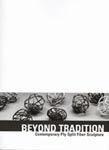 Beyond Tradition: Contemporary Ply-Split Fiber Sculpture. Exhibition catalog, Contemporary Crafts Museum and Gallery, 2004. 40 pages, 5"x7", 25 black and white photos. Twenty-five artists from five countries (US, England, India, Japan, and Switzerland). Artist statements and one B&W photo of the work of each artist. This is the catalog for the first exhibition of contemporary ply-splitting held in America, October 2-November 14, 2004, in Portland, Oregon. The exhibition was organized by Lisa Conte, and features the work of 11 invited artists, and 14 juried artists. The catalog includes a page for each artist with their statement and a photo of their work. This is a lovely catalog, and an important document in the history of ply-splitting.
Beyond Tradition: Contemporary Ply-Split Fiber Sculpture. Exhibition catalog, Contemporary Crafts Museum and Gallery, 2004. 40 pages, 5"x7", 25 black and white photos. Twenty-five artists from five countries (US, England, India, Japan, and Switzerland). Artist statements and one B&W photo of the work of each artist. This is the catalog for the first exhibition of contemporary ply-splitting held in America, October 2-November 14, 2004, in Portland, Oregon. The exhibition was organized by Lisa Conte, and features the work of 11 invited artists, and 14 juried artists. The catalog includes a page for each artist with their statement and a photo of their work. This is a lovely catalog, and an important document in the history of ply-splitting.
by Jennie Parry:
"A Miracle of Invention: Peter Collingwood discusses ply-split braiding" Embroidery,Volume 53 No.2, 2002. Jennie Parry interviews Peter Collingwood about ply-splitting. Includes photos of work by several artists, and a bibliography.
by Jennie Parry, Ralph & Ann Norman, Editing Team:
Expanding the Girths, Sagaman, Aston Road, Bampton, Oxfordshire OX18 2AL UK, 54 pages, spiral bound, 2001.. A collection of articles and color photographs, published to coincide with the exhibition "Expanding the Girths: Traditional and Contemporary Ply-Split Braiding". You can see photos from the exhibition in my Ply-Splitting Gallery.
by Betsy Quick and Judith Stein:
 Ply-Split Camel Girths of West India, 64 pages, 1982.
64 pages,Fowler Museum, UCLA, 1982. 8-1/2" x 11", many black and white photos, diagrams, and instructions, This is the first book documenting the traditional ply-split braiding of the Thar Desert of India, and will be of interest to textile historians, collectors, and fiber artists. The field research was conducted in the late 1970s, when the authors were graduate students at UCLA. They stayed in India for several months, and spent countless hours with the ply-split braiding master Ishwar Singh. As part of their research, they photographed the traditional steps of preparing goat hair, including spinning it into yarn, plying the yarn into cords, and ply-splitting the cords into girths. The authors blazed the trail later followed by Peter Collingwood, whose comprehensive book, The Techniques of Ply-Split Braiding, was published in 1998.
Ply-Split Camel Girths of West India, 64 pages, 1982.
64 pages,Fowler Museum, UCLA, 1982. 8-1/2" x 11", many black and white photos, diagrams, and instructions, This is the first book documenting the traditional ply-split braiding of the Thar Desert of India, and will be of interest to textile historians, collectors, and fiber artists. The field research was conducted in the late 1970s, when the authors were graduate students at UCLA. They stayed in India for several months, and spent countless hours with the ply-split braiding master Ishwar Singh. As part of their research, they photographed the traditional steps of preparing goat hair, including spinning it into yarn, plying the yarn into cords, and ply-splitting the cords into girths. The authors blazed the trail later followed by Peter Collingwood, whose comprehensive book, The Techniques of Ply-Split Braiding, was published in 1998.
by Noemi Speiser:
The Manual of Braiding, first edition, 1983; third edition, 1991. This most complete overview of braiding includes information about ply-splitting.
by Barbara Walker:
"Color Play: Designing Ply-Splitting Cords", Complex Weavers Journal, October 2014, pp. 9-13.
Ply-Splitting from Drawdowns: Interpreting Weave Structures in Ply-Split Braiding, 2012. 49 pages, black & white instruction diagrams and photos, color gallery pages.
"Learn Ply-Splitting with Two Summer Trivets", Handwoven, March/April 2011, p. 41-42.
Ply-Splitting Tools
The Bradshaw Cordmaker is a twister head which you attach to a hand or power drill. It is my favorite tool for making a lot of cords, and I use it all the time in my studio attached to an electric drill. You can watch my video that shows how I use the Bradshaw cordmaker to make cords for ply-splitting from paper ribbon. The Bradshaw cordmaker is available from Louise French.
Anna Crutchley's Cordtwister is made in England, and has been specially designed for tassel making, embroidery and soft furnishing, as well as ply-split braiding. It comes with a holding bracket, a 4-hook plate, and a step-by-step user's guide. Available from Anna Crutchley .
Gripfids
This wonderful tool was developed by Stuart Grainger for rope splicing, and is excellent for ply-split braiding. My husband, John, makes gripfids from hollow knitting needles. These are available by mail order from my Ply-Splitting Tools page. You can learn to make your own gripfids by watching John's video on YouTube.
Louise French -- another supplier in the US.
In England, gripfids are available from Helen Leaf.
Latch Hooks
These are used for rug hooking, and work for ply-split braiding when using fairly soft cords that are about 1/8" in diameter. They can be found in craft stores and fabric stores. I have found them in Portland at Michael's Arts & Crafts, Fabric Wholesalers, and sometimes at Goodwill.
The Braid Society
The Braid Society, founded in 1993 and based in the United Kingdom, has members from all over the world. This is an organization of people interested in all sorts of "narrow wares" - looping, braiding, kumihimo, tablet, inkle, lucet, ply splitting, finger weaving, even sprang. Some members specialize in one or more techniques and are published authors, others are beginners, and some just love to collect braids and bands but don't make them.
The Braid Society organizes lectures, workshops, museum trips, exhibitions and demos. Meetings are only in the UK and Ireland at the moment, but any members planning on visiting the UK are welcome to sign up for our
events. All members receive the newsletter, 4 issues a year, and the annual journal Strands which has in-depth articles and color photos.
The Braid Society has a web page, www.braidsociety.com/, and an Internet discussion list open to non-members as well as members.
Textile-Related Links
Fiber Art Instruction in the Portland Area
Yarn, Supplies, Books & Magazines
Organizations
Galleries & Museums
Weavers' web sites
Fiber Art Instruction in the Portland Area
Private instruction in my studio
Damascus Fiber Arts School
Multnomah Arts Center
Oregon College of Art and Craft
Ruthie's Weaving Studio
Yarn, Supplies, Books & Magazines
Aurora Silk, Portland, OR
Braidershand, Coupeville, WA
Frank's Cane and Rush Supply, Huntington Beach, CA
Giovanna Imperia Designs, Houston, TX
Halcyon Yarn, Bath, ME
Interweave Press -- Handwoven magazine
Hillcreek Fiber Studio, Columbia, MO
Textura Trading Company, Easthampton, MA
Unicorn Books, Petaluma, CA
The Woolery, Murfreesboro, NC
Yarn Barn, Lawrence, KS
Yarn Garden, Portland, OR; 503-239-7950
Organizations
ANWG -- Association of Northwest Weaving Guilds
Columbia Basin Basketry Guild
Handweavers Guild of America
National Basketry Organization
Portland Handweavers Guild
WARP (Weave A Real Peace)
The Center for Traditional Textiles of Cusco
Galleries & Museums
The Peter Collingwood Ethnographic Collection
Marla Mallett Textiles and Tribal Oriental Rugs, Atlanta, GA
Mission Mill Museum, Textile Learning Center, Salem, OR
The Textile Museum, Washington, DC
Weavers, Basketmakers, Fiber Artists
Wendy Bialek -- Custom weaving, interior design, ceremonial wear, labyrinth fiber art mountain retreats, weaving for wellness
Rosemary Brock -- TextileLinks
Nanette Davis -- Plaited sculptures and vessels, wall sculptures, jewelry, shiboried wearables
Sarah Haskell-- Woven Voices and Mandala Community Weaving
Carol James, Sashweaver: Fingerweaving and sprang.
Karen Madigan Weave Textiles & Design and The Curious Weaver
Janis Saunders Tablet weaving, ply-splitting, kumihimo
Barbara Shapiro -- Loom weaving, dyeing, tablet weaving
Garden Art from Recycled Materials
The mission of Cracked Pots is to create garden art from recycled materials. Formed in 1999, Cracked Pots has featured the work of more than 160 northwest artists.
Mindfulness Practice
Mindfulness is the practice of being aware of and living deeply in the present moment.
The Portland Community of Mindful Living has several sanghas that practice in the tradition of Vietnamese Zen Master, poet, and peace activist Thich Nhat Hanh. I've been a member of the Joyful Refuge Sangha of the Portland Community of Mindful Living since 2000. We meet on Monday nights, at the Friends Meeting House, 4312 SE Stark Street in Portland. The room opens at 7:00pm, with meditation starting at 7:15pm. Our practice ends at 9:00pm. We have sitting and walking meditation, singing, readings (usually from books by Thich Nhat Hanh), and sharing. For more information, please feel free to contact me.
Thich Nhat Hanh currently lives in Plum Village, a Buddhist training monastery he founded in France. He is the author of more than 35 books in English, including Teachings on Love and For A Future To Be Possible. I find his particular words and the way he expresses his beliefs very touching and inspiring. Many of his books are published by Parallax Press.
The following list of aspirations was developed by Dharma Teacher Jerry Braza and Blaze Compton. Several colleges and universities are beginning to use these points to create dialogue with students on how they can live their lives more deeply and mindfully.
These aspirations offer a guiding light and encouragement to look deeply at ourselves and our interactions with the world. They are based on the Mindfulness Trainings found in the Plum Village Chanting and Recitation Book, compiled by Thich Nhat Hanh and the Monks and Nuns of Plum Village, published by Parallax Press in 2000.
1. I aspire to live more fully in the present moment, thus deepening my relationships with all beings.
2. I aspire to develop respect for and extend compassion to all living beings.
3. I aspire to embrace a livelihood that supports the well-being of my society and the environment.
4. I aspire to cultivate generosity by sharing my time, energy, and resources with those in need.
5. I aspire to protect the safety and the integrity of all relationships by upholding trust and fidelity as unifying principles between couples, in families, and in society.
6. I aspire to listen deeply and to speak lovingly to support others during times of suffering and of joy.
7. I aspire to consume in ways that promote physical and emotional well-being for myself, my family, and my society.
8. I aspire to generate calmness and peace in myself and in my environment by the daily practice of deep inner reflection, meditation, and/or contemplation.
9. I aspire to open my mind to all cultures, faiths, and ethnicities, thus nurturing my understanding of all beings.
10. I aspire to be a peacemaker by practicing non-violent means to solve problems and by being mindful in times of conflict.
Places for walking meditation:
Earth Sanctuary, Whidbey Island, Washington
Healthy Cooking and Eating
Our Favorite Recipes:
A small collection of recipes that John and I enjoy on a regular basis.
Food and nutrition websites:
NutritionFacts.org Dr. Michael Greger's website, featuring short videos on the latest science on food and nutrition.
Cathy Fisher's blog, Straight Up Food. Cathy is a chef and teacher whose passion is creating recipes without animal foods, salt, oil or sugar, and very few processed foods.
The Joy of Mindful Cooking
Dr. Joel Fuhrman's Nutritarian Diet
PlantPure Nation
The World's Healthiest Foods
PDX Veg
Northwest Veg
Cookbooks:
The How Not to Die Cookbook by Michael Greger, MD, with Gene Stone
The PlantPure Nation Cookbook by Kim Campbell
The Eat to Live Cookbook by Joel Fuhrman, MD
The China Study Quick & Easy Cookbook by Del Sroufe
The World's Healthiest Foods by George Mateljan
Books:
How Not to Die by Michael Greger, MD. with Gene Stone
Eat to Live by Joel Fuhrman, MD
The End of Dieting by Joel Fuhrman, MD
The Starch Solution by John McDougall, MD
Portland restaurants:
Laughing Planet Cafe, 3320 SE Belmont Street
Pepino's Fresh Mexican Grill, 3832 SE Hawthorne Blvd.
Portland grocery stores:
People's Food Co-op
Tablet Weaving Gallery
Ply-Splitting Gallery
Shop
Home
This page updated on November 20, 2024.
![]()


 Ecclesiastical Pomp & Aristocratic Circumstance: A Thousand Years of Brocaded Tabletwoven Bands, 315 pages, paperback, self-published in 2000. For anyone interested in the history of textiles, especially those who wish to reproduce brocaded tablet-woven bands with historical accuracy. Approximately 70 historical patterns never before published, glossary, extensive annotated bibliography, and detailed documentation on every known brocaded tablet-woven band made in Europe between 600 and 1600. At the time, these textiles of silk and precious metallic threads were "one of the most luxurious forms of personal ornament". Charming line drawings of medieval churchmen and royalty show exactly where the bands were placed, from their headpieces right down to their shoes. Exhaustive analysis of colors and dyes, threads, weaving methods, and tools used by medieval tablet weavers.
Ecclesiastical Pomp & Aristocratic Circumstance: A Thousand Years of Brocaded Tabletwoven Bands, 315 pages, paperback, self-published in 2000. For anyone interested in the history of textiles, especially those who wish to reproduce brocaded tablet-woven bands with historical accuracy. Approximately 70 historical patterns never before published, glossary, extensive annotated bibliography, and detailed documentation on every known brocaded tablet-woven band made in Europe between 600 and 1600. At the time, these textiles of silk and precious metallic threads were "one of the most luxurious forms of personal ornament". Charming line drawings of medieval churchmen and royalty show exactly where the bands were placed, from their headpieces right down to their shoes. Exhaustive analysis of colors and dyes, threads, weaving methods, and tools used by medieval tablet weavers. Tablet Weaving Magic: Patterns from Oriental Countries and 25 Patterns in Plain Tablet Weave, 250 pages, paperback, self-published in 2000 with text in both English and German. Otfried Staudigel has been teaching tablet weaving for over 50 years. In this book, he clearly explains his methods, and presents instructions and graphs for weaving beautiful traditional designs from Asia. The section on double-faced designs includes Persian bands with peacocks, flowers, and the tree of life; as well as Burmese bands with incense burners, parasols, bells, people, birds, and animals. The section on warp-twined bands includes a valuable and detailed description of using the continuous warping method for patterns determined by the threading; this involves cutting and tying on new colors as needed. The 25 patterns include the Running Dog, Ram's Horn, and Star of David.
Tablet Weaving Magic: Patterns from Oriental Countries and 25 Patterns in Plain Tablet Weave, 250 pages, paperback, self-published in 2000 with text in both English and German. Otfried Staudigel has been teaching tablet weaving for over 50 years. In this book, he clearly explains his methods, and presents instructions and graphs for weaving beautiful traditional designs from Asia. The section on double-faced designs includes Persian bands with peacocks, flowers, and the tree of life; as well as Burmese bands with incense burners, parasols, bells, people, birds, and animals. The section on warp-twined bands includes a valuable and detailed description of using the continuous warping method for patterns determined by the threading; this involves cutting and tying on new colors as needed. The 25 patterns include the Running Dog, Ram's Horn, and Star of David.
 Woven Images, Unravelled Motifs: Double-Faced Tablet-Woven Bands from Burma, Tibet and Tunisia. 192 pages, paperback, self-published in 2008 with text in both English and German. In this book, Otfried Staudigel continues his valuable work that he first shared in Tablet-Woven Magic, this time exclusively focusing on double-faced bands. The majority of graphs in this book are from Burmese manuscript binding ribbons known as sazigyo. These designs include several examples of the Zey Yattu, the opening prayer for good auspices, and many other images important in Buddhist iconography that appear on sazigyo, including a variety of animals, frogs, fish, trees and flowers, gongs, bells, nats (spiritual beings), and ritual objects. Otfried has researched meanings of the images, and shares this information in the text that accompanies the graphs.
Woven Images, Unravelled Motifs: Double-Faced Tablet-Woven Bands from Burma, Tibet and Tunisia. 192 pages, paperback, self-published in 2008 with text in both English and German. In this book, Otfried Staudigel continues his valuable work that he first shared in Tablet-Woven Magic, this time exclusively focusing on double-faced bands. The majority of graphs in this book are from Burmese manuscript binding ribbons known as sazigyo. These designs include several examples of the Zey Yattu, the opening prayer for good auspices, and many other images important in Buddhist iconography that appear on sazigyo, including a variety of animals, frogs, fish, trees and flowers, gongs, bells, nats (spiritual beings), and ritual objects. Otfried has researched meanings of the images, and shares this information in the text that accompanies the graphs. 



 by Claudia Wollny
by Claudia Wollny




